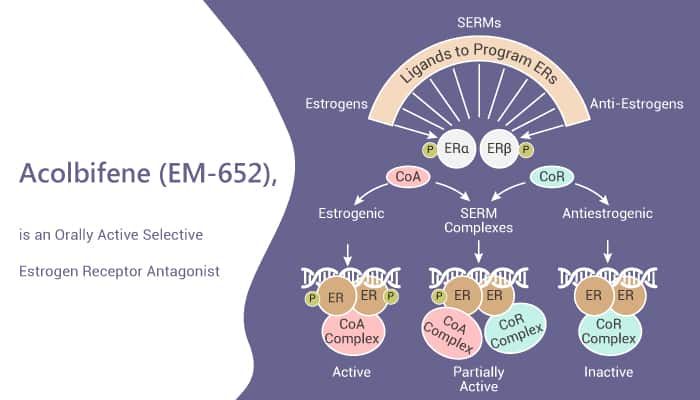There are two different forms of the estrogen receptor ERα and ERβ. Acolbifene (EM-652) is an orally active selective estrogen receptor antagonist. In particular, Acolbifene is a cancer-preventing selective estrogen receptor modulator (SERM). Acolbifene exerts a potent and pure anti-estrogenic action in the mammary gland and uterus. In addition, Acolbifene displays beneficial, estrogen-like actions on energy and lipid metabolism in rodents. Especially, Acolbifene shows a high affinity for binding to both ERα and ERβ.

Acolbifene shows the most potent inhibition of estradiol-stimulated cell proliferation in human breast cancer cells (ZR-75-1, MCF-7, and T-47D). Moreover, Acolbifene prevents bone loss and lowers serum cholesterol and triglyceride levels.
Acolbifene reduces food intake and weight gain similarly in both dietary cohorts. In this study, Acolbifene reduces cholesterolemia by 33% in rats fed the reference diet. Acolbifene increases protein abundance of the scavenger receptor, class B, type 1, and the LDL receptor in livers of rats fed the reference diet. Besides, Acolbifene reduces bone mineral mass loss and improves the lipoprotein profile in rodents. Acolbifene dramatically reduces circulating cholesterol in rats. Furthermore, Acolbifene exerts an estrogen-like effect on food intake, which in turn reduces adipose tissue accretion in rats.
Acolbifene reduces food intake and strongly decreases cholesterolemia in rats fed a cholesterol-free diet. As a result, Acolbifene reduces cholesterol independently of changes in food intake. Moreover, Acolbifene inhibits both AF1 (ligand-independent) and AF2 (ligand-dependent) of both ERα and ERβ. All in all, Acolbifene acts as a hypocholesterolemic agent because its action is largely maintained in rats with severe diet-induced hypercholesterolemia.